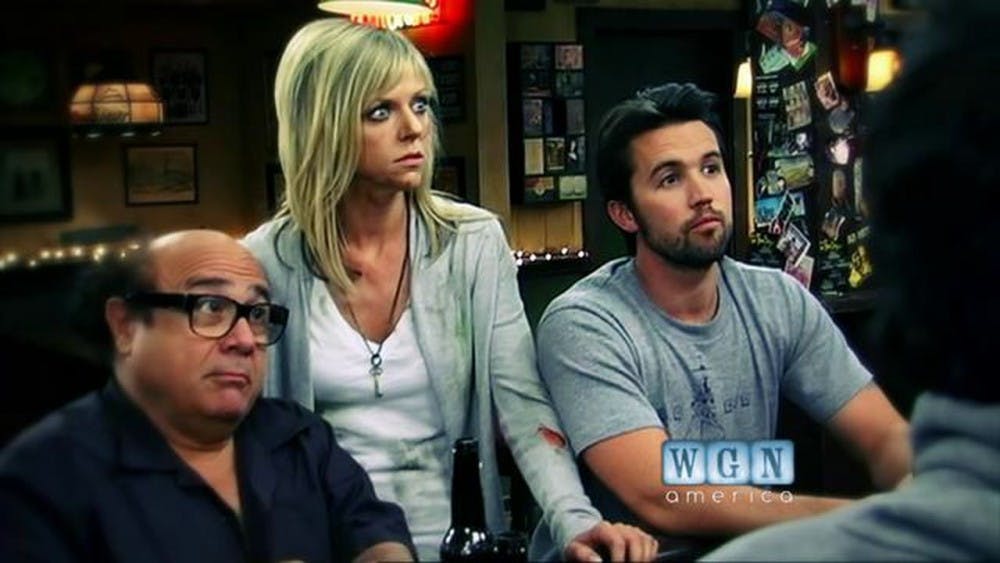For a television show in its 12th season, “It’s Always Sunny in Philadelphia” has made a particularly concerted effort to walk the balancing beam between innovation and authenticity. Perhaps it’s due to a desire to fight the banality that plagues long-running TV shows or the understanding that reinvention is crucial to successful comedies. Regardless, there’s been a clear attempt at taking risks in the newest season of “It’s Always Sunny,” but there’s a semblance of restraint present, too–as if the show’s creators aren’t quite comfortable with breaking the confines of its established structure just yet.
True, most sitcoms would’ve found their sweet spot by now, churning out more filler episodes than those that drive the plot forward and settling into a foreseeable array of episodic antics and gags. And, undeniably, “It’s Always Sunny in Philadelphia” fits the bill of a predictable situation comedy–each episode finds the Gang, a hedonistic group of sociopaths who run a seedy bar in south Philly, thrust into an outrageous scenario. (Cue episode titles such as “The Gang Exploits the Mortgage Crisis” and “Frank Sets Sweet Dee on Fire.”) Whether the situation arises through external forces or by their own idiotic hands, the Gang responds accordingly and abrasively until the episode’s close.
But “It’s Always Sunny,” which has garnered a devoted, cult-like following since its first season aired in 2005, is far from content with simply chugging along until its record-tying (and perhaps final) 14th season. By now, the main characters have been molded enough over the seasons to warrant a measure of creative liberty in progressing the series. And the show has already ventured into different episode structures in the past, such as with “Charlie Work” and “Being Frank,” which took artistic freedom with both direction and tone. Notably, those episodes are some of the most highly lauded in the series. When “It’s Always Sunny” commits fully to its riskier ideas, it pays off.
It’s natural, then, that the show’s writers looked to similar modes of storytelling to enrich the latest season. The season’s first episode, “The Gang Turns Black,” was a musical. “Old Lady House: A Situation Comedy” was structured as a traditional cable network sitcom with an indulgent laugh track. “Making Dennis Reynolds a Murderer” was a spoof of true crime documentaries. They upended the show’s convention, structure and style, similar to how other episodes had. So why did every episode seem to just slightly miss the mark?
It feels as though the show has become too self-aware for its own good. “It’s Always Sunny” has never shied away from the more meta aspects of comedy–after all, social commentary filtered through the worldviews of horrifically narcissistic people is a guaranteed hit–but when the observations are borderline patronizing, the joke is somewhat devalued. When Charlie and Mac edit together a documentary that indicts Dennis for the murder of his ex-wife, Dennis indignantly points out that the police found verifiable evidence of his innocence–to which Mac responds, “People don’t want to see that, because it’s hard evidence. It’s better to actually sit on that evidence until, like, episode 10.” And while his comment isn’t untrue, it’s somehow too forthright for a pair as idiotic as Mac and Charlie. When “It’s Always Sunny” embeds its social satire (on abortion, gun control, blackface) into the twisted psyche and actions of its main characters, the jokes are both funnier and more authentic.
Still, season 12 of “It’s Always Sunny” delivered excellently on many of its long-building plot points. The series has danced around certain aspects of the characters’ personal lives (such as Mac’s closeted homosexuality and Charlie’s unhealthy infatuation with the Waitress) for quite some time. Stalling on their development any longer would squander much-needed opportunities for unexplored storylines late in the series. Thankfully, “It’s Always Sunny” realized this fact. In “Hero or Hate Crime?” Mac comes out as gay–for good. In “Dennis’ Double Life,” Charlie finally sleeps with the Waitress–and she might be carrying his child. Not only have viewers been waiting for these moments to happen since the onset of the show, but “It’s Always Sunny” now has innumerable directions to take the characters and their stories in.
The series needs these experimentations with structure and storylines, because “It’s Always Sunny” is on the horizon of radical change. In the last scene of season 12, Dennis Reynolds, played by Glenn Howerton, exclaims that he’s done with the Gang’s childish capers and their inability to take anything seriously, ending his tirade with a dramatic exit of the bar in order to pursue a life with his recently-discovered illegitimate son in South Dakota. As it turns out, what might’ve been an amusing fish-out-of-water story arc for a couple episodes in season 13 might actually be a way to permanently write Howerton out of the show. Whether or not the series can handle the loss of (arguably) its best actor and most entertaining character remains to be seen, but as demonstrated by the latest season of “It’s Always Sunny,” the show is willing to take risks to compensate–it just needs to be a bit more diligent about its commitment to such gambles.
Get The Chronicle straight to your inbox
Signup for our weekly newsletter. Cancel at any time.

